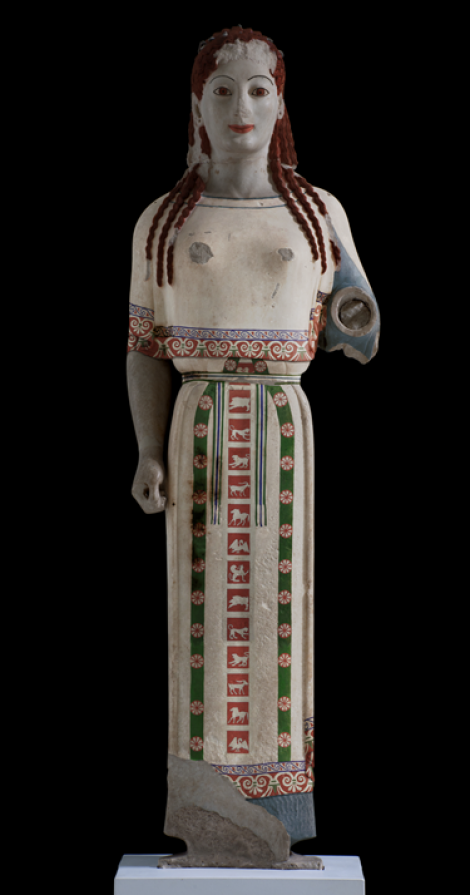by James Beresford for Museums Journal
Opening to international fanfare in June 2009, the €129m New Acropolis Museum has become the embodiment of the Greek desire to see Elgin's marble trophies returned to Athens. However, the paying public has been less-than-impressed with the museum, which has failed to attract the visitor numbers that were predicted.
In 2006 journalist Tom Flynn noted: "The old Acropolis Museum currently attracts around 1.5 million people each year. The Greeks hope their New Acropolis Museum will at least double that figure."
In an interview in Time a year later, Dimitrios Pandermalis, the current president of the museum, anticipated in excess of two million visitors passing annually through the doors.
The museum has, however, failed to meet such expectations. In the four years since opening, 5,440,343 people have visited the museum – considerably fewer than the eight million its president envisioned.
Opening in the teeth of the economic recession, the low visitor numbers are partly understandable. Nonetheless, the rapid decline in attendance over the course of the New Acropolis Museum's short lifetime is worrying.
During its first year of operation (June 2009/May 2010), visitor numbers were a creditable 1,950,539, falling just shy of the two million anticipated by Pandermalis.
Since then, however, there has been a steep fall-off in attendance and the latest figure of 1,036,059 (June 2012/May 2013) reveals a drop of almost 50% in only three years. Equally unsettling is the plummeting position of the New Acropolis Museum compared with other international museums.
Attendance figures compiled by the Art Newspaper placed the New Acropolis Museum in 25th position in 2010 (the first full calendar year it was open to the public). The museum dropped 13 places in 2011, and an additional 21 places in 2012, finishing last year in 59th position – a fall of 34 places in just two years.
There are some grounds for optimism; the declining trend in visitor numbers should be reversed in 2013 as Greece benefits from the political upheavals affecting rival tourist destinations such as Egypt and Turkey. However, a reliance on the instability of neighbouring countries scarcely guarantees a bright future for the museum.
Restitutionists petitioning for the return of Elgin's keepsakes have greeted the disappointing attendance figures at the New Acropolis Museum with deafening silence – hardly surprising since drawing attention to the lacklustre performance can only damage attempts to repatriate the marbles.
However, it is hoped that the campaign groups meeting in Sydney this November will grasp the nettle and take time away from their usual diatribes against the British Museum to ask some searching questions of Greek culture officials in attendance.
James Beresford is a writer based in Athens. He is currently writing a book on the effects of the economic crisis on the Greek heritage sector.
Eddie O'Hara Chairman, The British Committee, For the Reunification of the Parthenon Marbles
05.09.2013, 17:03
Attendance figures are irrelevant to the case for reunification of the Parthenon sculptures. Indeed why not send them to Beijing? More important than numbers is the quality of the NAM, which was recently adjudged by The Times (* The world's 50 best museums, 11 May 2013) to be the third of the top fifty museums in the world. Central to its purposes is to provide the best possible presentation and narrative of the sculptures of the Parthenon. Their preeminence merits this. The NAM has demonstrated that it can provide it. And then there are the cultural and ethical grounds for reunification.
James Beresford
05.09.2013, 22:18
Dear Mr O'Hara, Thank you for your comments. I very much respect your dedication to the reunification cause and I found your speeches at last year's London colloquy very interesting. Despite what you and others clearly think, I should state that I'm not opposed to the repatriation of the Marbles to Athens and I would actively support an immediate loan deal to help boost tourism into Greece in an effort to combat the country's financial crisis (and maybe even boost morale). I would, however, just like to make a couple of points. Re: The Times list from May. This underscores the point of the above article. Within a week of publication it was being referenced not only in Britain but here in Athens, with Greek journalists dispassionately(?) reporting: 'second [on The Times list] is the British Museum in London, which houses the stolen Parthenon Marbles that officials refuse to return to Greece.' (http://eu.greekreporter.com/2013/05/14/acropolis-museum-worlds-3d-best/). The President of the Acropolis Museum would also quickly refer to The Times list. By contrast, not a single newspaper, campaign group or museum official has noted the dramatic nose-dive in the position of the Acropolis Museum which became clear when the far more comprehensive Art Newspaper 'league table' appeared a month earlier. As you neglected to mention, The Times list was also compiled from group of just nine (British/British-based) critics and historians pre-selected by the newspaper; by contrast, the Art Newspaper survey reflected the interests of millions of international museum-goers. (You might also be forgetting that some of the Universal Museums, such as the Louvre or the Met, were purposely excluded from the The Times list.) In respect to your assertion that attendance figures are an irrelevance, might I just remind you of one of your own Early Day Motions from when you were pushing the repatriation cause as a British MP. You noted that 'the Greek Government has commissioned a new Acropolis Museum at a cost of £29 million to be situated at the foot of the Acropolis,' and which you went on to claim was expected to bring an 'estimated three million visitors per annum to the Acropolis Museum from around the world... when it is opened at the time of the Athens Olympics in 2004.' (http://www.edms.org.uk/2001-02/336.htm). If museum attendance is 'irrelevant', then why use visitor numbers as a central plank in your argument to fellow MPs? If visitor numbers were relevant before the museum opened then why aren't they valid now? However, given that you managed to exaggerate annual visitation to the Acropolis Museum by almost three times its current figure, I fully understand your annoyance at my article. (Did you at least receive a cash prize for managing the clean sweep of grossly inflated attendance figures; an opening date that proved five years too optimistic; underestimating the construction costs of the museum by a mere £80 million?) I apologise for being rude at your expense, but it is this romantic naiveté in respect to the Marbles that have cost Greek and European taxpayers millions of euros – money which could sorely be used right now to assist the homeless we see on Athenian streets each day, or to help other museums and archaeological sites get through this period of austerity. By all means go to Sydney and discuss 200 year-old legal issues, or debate how the Parthenon is an 'Icon of Global Citizenship.' However, please don't neglect to raise the question of WHY the Acropolis Museum is hemorrhaging visitors, and WHAT CAN BE DONE to reverse the trend. We all want the museum to be a success, but to be so it requires the lifeblood of money that flows from paying visitors: deserted galleries and empty cash tills are a poor return on £110 million. To borrow from Carville: 'It's the economy, stupid.'
Eddie O'Hara Chairman, The British Committee, For the Reunification of the Parthenon Marbles
08.09.2013, 19:03
Dear Mr Beresford, thank you for giving so much attention to my observations on your article about the decline in recorded attendances at the NAM. I am grateful for your courteous comments but found it novel as a calloused veteran of Militant era politics on Merseyside to be described as a "romantic idealist". I also have an aversion to the overuse of the word "passionate" by certain politicians to describe their convictions. I do however confess to a principled commitment to the case for the reunification of the sculptures of the Parthenon and am pleased to note that you also are not unsympathetic to this. This commitment has nothing to do with statistics of attendance, whether at the BM or at the NAM. Indeed it was the BM which first introduced this factor when it disingenuously claimed that 5 million visitors annually visited their Duveen Gallery when of course this figure referred to those coming through the front entrance. By contrast one may be confident that almost everyone passing through the front entrance of the NAM will visit its Parthenon gallery. You refer to an old EDM of mine in which you describe the mention of projected attendance figures as a "central plank". Not so. This was introductory descriptive detail from the then prospectus of the planned museum. The central planks were the project of a museum dedicated to the narrative of the Acropolis and the Parthenon in particular, its location "at the one place on earth where it is possible to have a simultaneous visual and aesthetic experience of the Parthenon and its sculptures", its glass walled roof gallery orientated to the ground plan of the Parthenon, and the fact that the gaps in the displays in this gallery would redound to the discredit of Britain in the eyes of foreign visitors. By contrast the filling of these gaps would bring us great credit.
The polls in The Times and the Art Newspaper are difficult to compare. The Times poll is admittedly based on the views of a selected group of experts. But their expertise does give credence to their listing. By the same token the BCRPM gave great credence to the poll last year of readers of the Museums Journal who by a large majority supported reunification of the Parthenon sculptures. The Art Newspaper poll as I understand it is based on simple visitor numbers. It is not surprising therefore that the big players (The Louvre, The Met, the BM, the Tate Modern and the National Gallery, all with the aid of big hitting temporary exhibitions) came first to fifth. For the NAM even to be placed in this company must have something to do with quality. The annual report of the NAM (available on line) gives evidence of this quality.
Finally I address your remarks about how the costs of what you come close to characterising as a white elephant could well have been spent on feeding the homeless in Greece. In the first place the costs of the NAM were incurred before the current economic crisis broke. Secondly it is a common fallacy to presume that public expenditure on one project might necessarily have been expended on another. Thirdly the costs of the NAM project incurred an EU subsidy not necessarily transferable to another project. Fourthly, as I understand it, the revenue costs of the NAM are not supported by subsidy from the public exchequer.
Having said all that, I am pleased that you share my wish that the NAM should be a success. The declining numbers of attendance are indeed a matter of serious concern which I am sure is being addressed by the Director and his Board. I am sure you join me in wishing them well in this.


 a huge 'happy birthday' wish!
a huge 'happy birthday' wish!




